Refine search
No keyword found to refine search
keywords EN
Places
Names
438 documents found
| 1 | 8 |
Documents per page :

Lalish
Gabriel Gauffre / Le Pictorium
LePictorium_0282186.jpg
View of the Lalish temples.
Lalish, located in the heart of Iraqi Kurdistan, is the most sacred site to the Yazidi. They must make the pilgrimage there at least once in their life, for six days, in order to pay their respects to Sheikh Adi ibn Musafir’s tomb, the founder of the religion. They are about 700 000 in Iraq. Founded in the 12th century, the religion mixes elements of Islam with local pre-Islamic beliefs, making them a major target during the expansion of the Islamic state in Iraq.
Lalish, located in the heart of Iraqi Kurdistan, is the most sacred site to the Yazidi. They must make the pilgrimage there at least once in their life, for six days, in order to pay their respects to Sheikh Adi ibn Musafir’s tomb, the founder of the religion. They are about 700 000 in Iraq. Founded in the 12th century, the religion mixes elements of Islam with local pre-Islamic beliefs, making them a major target during the expansion of the Islamic state in Iraq.

Lalish
Gabriel Gauffre / Le Pictorium
LePictorium_0282187.jpg
View of the Lalish temples.
Lalish, located in the heart of Iraqi Kurdistan, is the most sacred site to the Yazidi. They must make the pilgrimage there at least once in their life, for six days, in order to pay their respects to Sheikh Adi ibn Musafir’s tomb, the founder of the religion. They are about 700 000 in Iraq. Founded in the 12th century, the religion mixes elements of Islam with local pre-Islamic beliefs, making them a major target during the expansion of the Islamic state in Iraq.
Lalish, located in the heart of Iraqi Kurdistan, is the most sacred site to the Yazidi. They must make the pilgrimage there at least once in their life, for six days, in order to pay their respects to Sheikh Adi ibn Musafir’s tomb, the founder of the religion. They are about 700 000 in Iraq. Founded in the 12th century, the religion mixes elements of Islam with local pre-Islamic beliefs, making them a major target during the expansion of the Islamic state in Iraq.
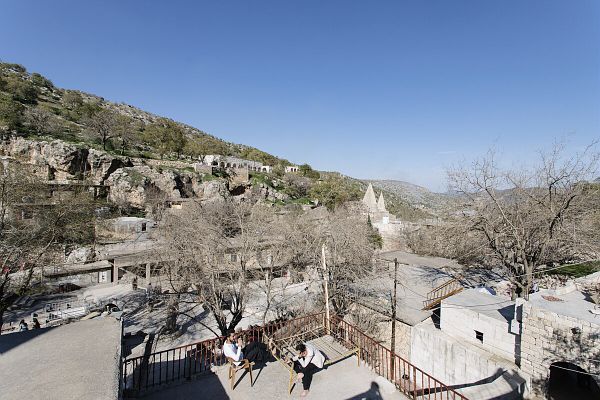
Lalish
Gabriel Gauffre / Le Pictorium
LePictorium_0282188.jpg
View of the Lalish temples.
Lalish, located in the heart of Iraqi Kurdistan, is the most sacred site to the Yazidi. They must make the pilgrimage there at least once in their life, for six days, in order to pay their respects to Sheikh Adi ibn Musafir’s tomb, the founder of the religion. They are about 700 000 in Iraq. Founded in the 12th century, the religion mixes elements of Islam with local pre-Islamic beliefs, making them a major target during the expansion of the Islamic state in Iraq.
Lalish, located in the heart of Iraqi Kurdistan, is the most sacred site to the Yazidi. They must make the pilgrimage there at least once in their life, for six days, in order to pay their respects to Sheikh Adi ibn Musafir’s tomb, the founder of the religion. They are about 700 000 in Iraq. Founded in the 12th century, the religion mixes elements of Islam with local pre-Islamic beliefs, making them a major target during the expansion of the Islamic state in Iraq.
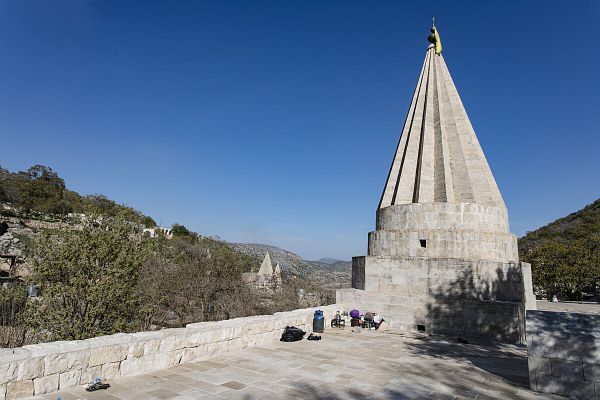
Lalish
Gabriel Gauffre / Le Pictorium
LePictorium_0282189.jpg
View of the Lalish temples.
Lalish, located in the heart of Iraqi Kurdistan, is the most sacred site to the Yazidi. They must make the pilgrimage there at least once in their life, for six days, in order to pay their respects to Sheikh Adi ibn Musafir’s tomb, the founder of the religion. They are about 700 000 in Iraq. Founded in the 12th century, the religion mixes elements of Islam with local pre-Islamic beliefs, making them a major target during the expansion of the Islamic state in Iraq.
Lalish, located in the heart of Iraqi Kurdistan, is the most sacred site to the Yazidi. They must make the pilgrimage there at least once in their life, for six days, in order to pay their respects to Sheikh Adi ibn Musafir’s tomb, the founder of the religion. They are about 700 000 in Iraq. Founded in the 12th century, the religion mixes elements of Islam with local pre-Islamic beliefs, making them a major target during the expansion of the Islamic state in Iraq.
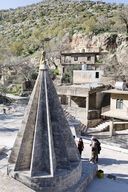
Lalish
Gabriel Gauffre / Le Pictorium
LePictorium_0282190.jpg
View of the Lalish temples.
Lalish, located in the heart of Iraqi Kurdistan, is the most sacred site to the Yazidi. They must make the pilgrimage there at least once in their life, for six days, in order to pay their respects to Sheikh Adi ibn Musafir’s tomb, the founder of the religion. They are about 700 000 in Iraq. Founded in the 12th century, the religion mixes elements of Islam with local pre-Islamic beliefs, making them a major target during the expansion of the Islamic state in Iraq.
Lalish, located in the heart of Iraqi Kurdistan, is the most sacred site to the Yazidi. They must make the pilgrimage there at least once in their life, for six days, in order to pay their respects to Sheikh Adi ibn Musafir’s tomb, the founder of the religion. They are about 700 000 in Iraq. Founded in the 12th century, the religion mixes elements of Islam with local pre-Islamic beliefs, making them a major target during the expansion of the Islamic state in Iraq.
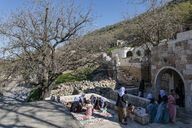
Lalish
Gabriel Gauffre / Le Pictorium
LePictorium_0282191.jpg
The faithful rest during a pilgrimage.
Lalish, located in the heart of Iraqi Kurdistan, is the most sacred site to the Yazidi. They must make the pilgrimage there at least once in their life, for six days, in order to pay their respects to Sheikh Adi ibn Musafir’s tomb, the founder of the religion. They are about 700 000 in Iraq. Founded in the 12th century, the religion mixes elements of Islam with local pre-Islamic beliefs, making them a major target during the expansion of the Islamic state in Iraq.
Lalish, located in the heart of Iraqi Kurdistan, is the most sacred site to the Yazidi. They must make the pilgrimage there at least once in their life, for six days, in order to pay their respects to Sheikh Adi ibn Musafir’s tomb, the founder of the religion. They are about 700 000 in Iraq. Founded in the 12th century, the religion mixes elements of Islam with local pre-Islamic beliefs, making them a major target during the expansion of the Islamic state in Iraq.
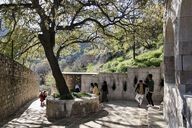
Lalish
Gabriel Gauffre / Le Pictorium
LePictorium_0282192.jpg
Pilgrims in Lalish.
Lalish, located in the heart of Iraqi Kurdistan, is the most sacred site to the Yazidi. They must make the pilgrimage there at least once in their life, for six days, in order to pay their respects to Sheikh Adi ibn Musafir’s tomb, the founder of the religion. They are about 700 000 in Iraq. Founded in the 12th century, the religion mixes elements of Islam with local pre-Islamic beliefs, making them a major target during the expansion of the Islamic state in Iraq.
Lalish, located in the heart of Iraqi Kurdistan, is the most sacred site to the Yazidi. They must make the pilgrimage there at least once in their life, for six days, in order to pay their respects to Sheikh Adi ibn Musafir’s tomb, the founder of the religion. They are about 700 000 in Iraq. Founded in the 12th century, the religion mixes elements of Islam with local pre-Islamic beliefs, making them a major target during the expansion of the Islamic state in Iraq.
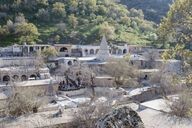
Lalish
Gabriel Gauffre / Le Pictorium
LePictorium_0282193.jpg
View of the Lalish temples.
Lalish, located in the heart of Iraqi Kurdistan, is the most sacred site to the Yazidi. They must make the pilgrimage there at least once in their life, for six days, in order to pay their respects to Sheikh Adi ibn Musafir’s tomb, the founder of the religion. They are about 700 000 in Iraq. Founded in the 12th century, the religion mixes elements of Islam with local pre-Islamic beliefs, making them a major target during the expansion of the Islamic state in Iraq.
Lalish, located in the heart of Iraqi Kurdistan, is the most sacred site to the Yazidi. They must make the pilgrimage there at least once in their life, for six days, in order to pay their respects to Sheikh Adi ibn Musafir’s tomb, the founder of the religion. They are about 700 000 in Iraq. Founded in the 12th century, the religion mixes elements of Islam with local pre-Islamic beliefs, making them a major target during the expansion of the Islamic state in Iraq.
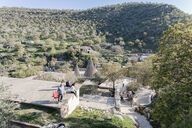
Lalish
Gabriel Gauffre / Le Pictorium
LePictorium_0282194.jpg
View of the Lalish temples.
Lalish, located in the heart of Iraqi Kurdistan, is the most sacred site to the Yazidi. They must make the pilgrimage there at least once in their life, for six days, in order to pay their respects to Sheikh Adi ibn Musafir’s tomb, the founder of the religion. They are about 700 000 in Iraq. Founded in the 12th century, the religion mixes elements of Islam with local pre-Islamic beliefs, making them a major target during the expansion of the Islamic state in Iraq.
Lalish, located in the heart of Iraqi Kurdistan, is the most sacred site to the Yazidi. They must make the pilgrimage there at least once in their life, for six days, in order to pay their respects to Sheikh Adi ibn Musafir’s tomb, the founder of the religion. They are about 700 000 in Iraq. Founded in the 12th century, the religion mixes elements of Islam with local pre-Islamic beliefs, making them a major target during the expansion of the Islamic state in Iraq.
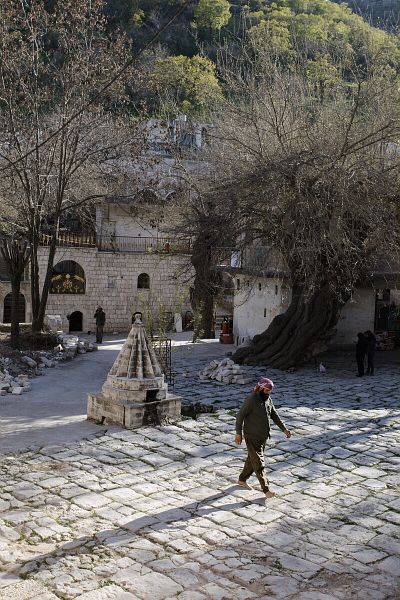
Lalish
Gabriel Gauffre / Le Pictorium
LePictorium_0282195.jpg
View of the Lalish temples.
Lalish, located in the heart of Iraqi Kurdistan, is the most sacred site to the Yazidi. They must make the pilgrimage there at least once in their life, for six days, in order to pay their respects to Sheikh Adi ibn Musafir’s tomb, the founder of the religion. They are about 700 000 in Iraq. Founded in the 12th century, the religion mixes elements of Islam with local pre-Islamic beliefs, making them a major target during the expansion of the Islamic state in Iraq.
Lalish, located in the heart of Iraqi Kurdistan, is the most sacred site to the Yazidi. They must make the pilgrimage there at least once in their life, for six days, in order to pay their respects to Sheikh Adi ibn Musafir’s tomb, the founder of the religion. They are about 700 000 in Iraq. Founded in the 12th century, the religion mixes elements of Islam with local pre-Islamic beliefs, making them a major target during the expansion of the Islamic state in Iraq.
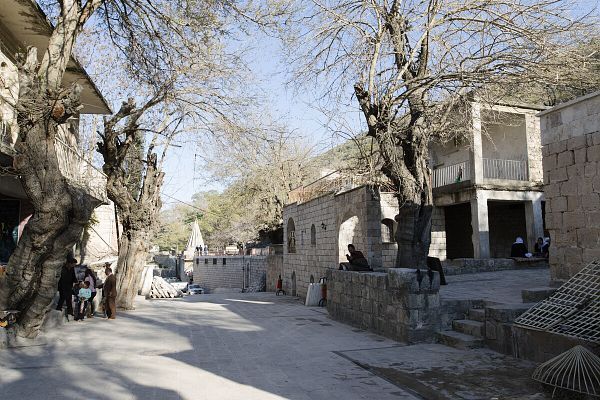
Lalish
Gabriel Gauffre / Le Pictorium
LePictorium_0282196.jpg
The main street of the Lalish religious complex.
Lalish, located in the heart of Iraqi Kurdistan, is the most sacred site to the Yazidi. They must make the pilgrimage there at least once in their life, for six days, in order to pay their respects to Sheikh Adi ibn Musafir’s tomb, the founder of the religion. They are about 700 000 in Iraq. Founded in the 12th century, the religion mixes elements of Islam with local pre-Islamic beliefs, making them a major target during the expansion of the Islamic state in Iraq.
Lalish, located in the heart of Iraqi Kurdistan, is the most sacred site to the Yazidi. They must make the pilgrimage there at least once in their life, for six days, in order to pay their respects to Sheikh Adi ibn Musafir’s tomb, the founder of the religion. They are about 700 000 in Iraq. Founded in the 12th century, the religion mixes elements of Islam with local pre-Islamic beliefs, making them a major target during the expansion of the Islamic state in Iraq.
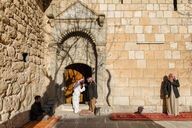
Lalish
Gabriel Gauffre / Le Pictorium
LePictorium_0282197.jpg
Pilgrims in Lalish.
Lalish, located in the heart of Iraqi Kurdistan, is the most sacred site to the Yazidi. They must make the pilgrimage there at least once in their life, for six days, in order to pay their respects to Sheikh Adi ibn Musafir’s tomb, the founder of the religion. They are about 700 000 in Iraq. Founded in the 12th century, the religion mixes elements of Islam with local pre-Islamic beliefs, making them a major target during the expansion of the Islamic state in Iraq.
Lalish, located in the heart of Iraqi Kurdistan, is the most sacred site to the Yazidi. They must make the pilgrimage there at least once in their life, for six days, in order to pay their respects to Sheikh Adi ibn Musafir’s tomb, the founder of the religion. They are about 700 000 in Iraq. Founded in the 12th century, the religion mixes elements of Islam with local pre-Islamic beliefs, making them a major target during the expansion of the Islamic state in Iraq.
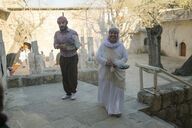
Lalish
Gabriel Gauffre / Le Pictorium
LePictorium_0282198.jpg
A priestess during a ceremony in Lalish.
Lalish, located in the heart of Iraqi Kurdistan, is the most sacred site to the Yazidi. They must make the pilgrimage there at least once in their life, for six days, in order to pay their respects to Sheikh Adi ibn Musafir’s tomb, the founder of the religion. They are about 700 000 in Iraq. Founded in the 12th century, the religion mixes elements of Islam with local pre-Islamic beliefs, making them a major target during the expansion of the Islamic state in Iraq.
Lalish, located in the heart of Iraqi Kurdistan, is the most sacred site to the Yazidi. They must make the pilgrimage there at least once in their life, for six days, in order to pay their respects to Sheikh Adi ibn Musafir’s tomb, the founder of the religion. They are about 700 000 in Iraq. Founded in the 12th century, the religion mixes elements of Islam with local pre-Islamic beliefs, making them a major target during the expansion of the Islamic state in Iraq.
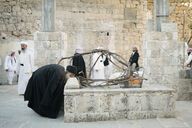
Lalish
Gabriel Gauffre / Le Pictorium
LePictorium_0282199.jpg
Lalish, located in the heart of Iraqi Kurdistan, is the most sacred site to the Yazidi. They must make the pilgrimage there at least once in their life, for six days, in order to pay their respects to Sheikh Adi ibn Musafir’s tomb, the founder of the religion. They are about 700 000 in Iraq. Founded in the 12th century, the religion mixes elements of Islam with local pre-Islamic beliefs, making them a major target during the expansion of the Islamic state in Iraq.
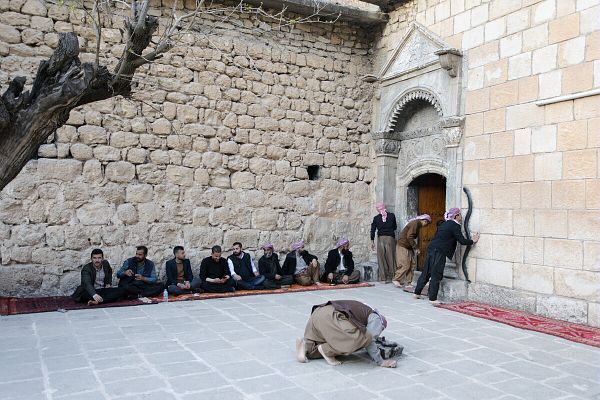
Lalish
Gabriel Gauffre / Le Pictorium
LePictorium_0282200.jpg
A pilgrim kisses a sacred stone in Lalish.
Lalish, located in the heart of Iraqi Kurdistan, is the most sacred site to the Yazidi. They must make the pilgrimage there at least once in their life, for six days, in order to pay their respects to Sheikh Adi ibn Musafir’s tomb, the founder of the religion. They are about 700 000 in Iraq. Founded in the 12th century, the religion mixes elements of Islam with local pre-Islamic beliefs, making them a major target during the expansion of the Islamic state in Iraq.
Lalish, located in the heart of Iraqi Kurdistan, is the most sacred site to the Yazidi. They must make the pilgrimage there at least once in their life, for six days, in order to pay their respects to Sheikh Adi ibn Musafir’s tomb, the founder of the religion. They are about 700 000 in Iraq. Founded in the 12th century, the religion mixes elements of Islam with local pre-Islamic beliefs, making them a major target during the expansion of the Islamic state in Iraq.
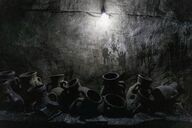
Lalish
Gabriel Gauffre / Le Pictorium
LePictorium_0282201.jpg
The Hesen Dana room, containing the jars filled with the oil used to light the temple's 365 lamps.
Lalish, located in the heart of Iraqi Kurdistan, is the most sacred site to the Yazidi. They must make the pilgrimage there at least once in their life, for six days, in order to pay their respects to Sheikh Adi ibn Musafir’s tomb, the founder of the religion. They are about 700 000 in Iraq. Founded in the 12th century, the religion mixes elements of Islam with local pre-Islamic beliefs, making them a major target during the expansion of the Islamic state in Iraq.
Lalish, located in the heart of Iraqi Kurdistan, is the most sacred site to the Yazidi. They must make the pilgrimage there at least once in their life, for six days, in order to pay their respects to Sheikh Adi ibn Musafir’s tomb, the founder of the religion. They are about 700 000 in Iraq. Founded in the 12th century, the religion mixes elements of Islam with local pre-Islamic beliefs, making them a major target during the expansion of the Islamic state in Iraq.
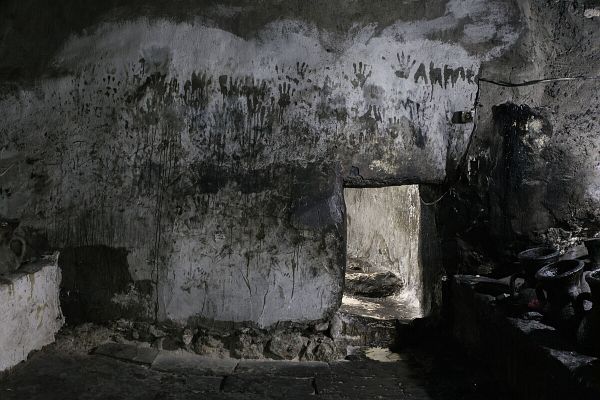
Lalish
Gabriel Gauffre / Le Pictorium
LePictorium_0282202.jpg
The Hesen Dana room, containing the jars filled with the oil used to light the temple's 365 lamps.
Lalish, located in the heart of Iraqi Kurdistan, is the most sacred site to the Yazidi. They must make the pilgrimage there at least once in their life, for six days, in order to pay their respects to Sheikh Adi ibn Musafir’s tomb, the founder of the religion. They are about 700 000 in Iraq. Founded in the 12th century, the religion mixes elements of Islam with local pre-Islamic beliefs, making them a major target during the expansion of the Islamic state in Iraq.
Lalish, located in the heart of Iraqi Kurdistan, is the most sacred site to the Yazidi. They must make the pilgrimage there at least once in their life, for six days, in order to pay their respects to Sheikh Adi ibn Musafir’s tomb, the founder of the religion. They are about 700 000 in Iraq. Founded in the 12th century, the religion mixes elements of Islam with local pre-Islamic beliefs, making them a major target during the expansion of the Islamic state in Iraq.
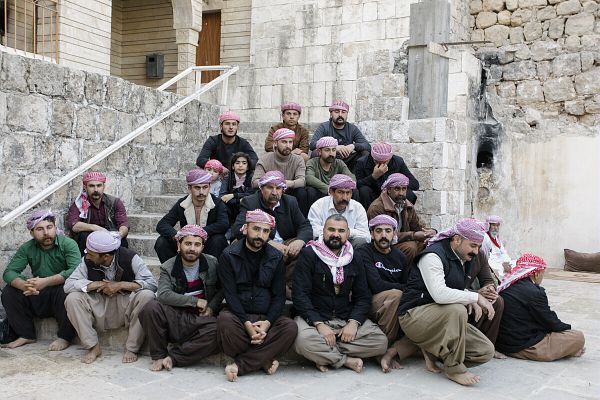
Lalish
Gabriel Gauffre / Le Pictorium
LePictorium_0282203.jpg
A group of Yezidi men in the temple's central courtyard.
Lalish, located in the heart of Iraqi Kurdistan, is the most sacred site to the Yazidi. They must make the pilgrimage there at least once in their life, for six days, in order to pay their respects to Sheikh Adi ibn Musafir’s tomb, the founder of the religion. They are about 700 000 in Iraq. Founded in the 12th century, the religion mixes elements of Islam with local pre-Islamic beliefs, making them a major target during the expansion of the Islamic state in Iraq.
Lalish, located in the heart of Iraqi Kurdistan, is the most sacred site to the Yazidi. They must make the pilgrimage there at least once in their life, for six days, in order to pay their respects to Sheikh Adi ibn Musafir’s tomb, the founder of the religion. They are about 700 000 in Iraq. Founded in the 12th century, the religion mixes elements of Islam with local pre-Islamic beliefs, making them a major target during the expansion of the Islamic state in Iraq.
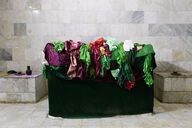
Lalish
Gabriel Gauffre / Le Pictorium
LePictorium_0282204.jpg
The tomb of Sheikh Adi ibn Musafir.
Lalish, located in the heart of Iraqi Kurdistan, is the most sacred site to the Yazidi. They must make the pilgrimage there at least once in their life, for six days, in order to pay their respects to Sheikh Adi ibn Musafir’s tomb, the founder of the religion. They are about 700 000 in Iraq. Founded in the 12th century, the religion mixes elements of Islam with local pre-Islamic beliefs, making them a major target during the expansion of the Islamic state in Iraq.
Lalish, located in the heart of Iraqi Kurdistan, is the most sacred site to the Yazidi. They must make the pilgrimage there at least once in their life, for six days, in order to pay their respects to Sheikh Adi ibn Musafir’s tomb, the founder of the religion. They are about 700 000 in Iraq. Founded in the 12th century, the religion mixes elements of Islam with local pre-Islamic beliefs, making them a major target during the expansion of the Islamic state in Iraq.
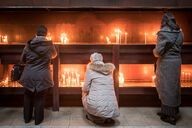
Orthodox Christian Lent
Olivier Donnars / Le Pictorium
LePictorium_0272383.jpg
Feb. 18, 2018: Faithful lighting candles in the Serbian Orthodox Church of St. Sava in Paris (75), France.
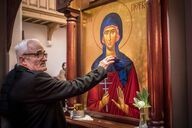
Orthodox Christian Lent
Olivier Donnars / Le Pictorium
LePictorium_0272384.jpg
Feb. 18, 2018: A worshipper touches an icon in the Serbian Orthodox Church of St. Sava in Paris (75), France.
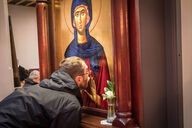
Orthodox Christian Lent
Olivier Donnars / Le Pictorium
LePictorium_0272385.jpg
February 18, 2018: Man kissing an icon, in the Serbian Orthodox Church of Saint Sava in Paris (75), France.
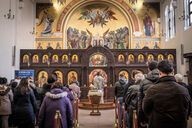
Orthodox Christian Lent
Olivier Donnars / Le Pictorium
LePictorium_0272386.jpg
February 18, 2018: Deacon facing the iconostasis during the pre-Lenten mass celebrated in St. Sava Serbian Orthodox Church. Paris (75), France.
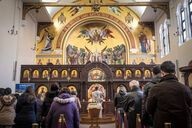
Orthodox Christian Lent
Olivier Donnars / Le Pictorium
LePictorium_0272387.jpg
February 18, 2018: Deacon facing the iconostasis during the pre-Lenten mass celebrated in St. Sava Serbian Orthodox Church. Paris (75), France.
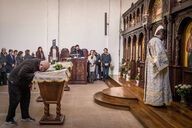
Orthodox Christian Lent
Olivier Donnars / Le Pictorium
LePictorium_0272388.jpg
February 18, 2018: pre-Lenten mass celebrated in the Serbian Orthodox Church of Saint Sava. Paris (75), France.
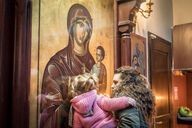
Orthodox Christian Lent
Olivier Donnars / Le Pictorium
LePictorium_0272389.jpg
February 18, 2018: In the Serbian Orthodox Church of St. Sava, a little girl kisses the icon representing a Virgin and Child. Paris (75), France.
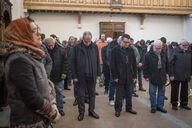
Orthodox Christian Lent
Olivier Donnars / Le Pictorium
LePictorium_0272390.jpg
February 18, 2018: pre-Lenten mass celebrated at St. Sava Serbian Orthodox Church. Parishioners recollecting themselves at the reading of the Our Father. Paris (75), France.
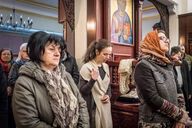
Orthodox Christian Lent
Olivier Donnars / Le Pictorium
LePictorium_0272391.jpg
February 18, 2018: pre-Lenten mass celebrated at St. Sava Serbian Orthodox Church. Parishioners signing themselves during the Our Father prayer. Paris (75), France.
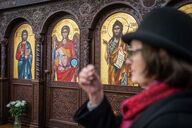
Orthodox Christian Lent
Olivier Donnars / Le Pictorium
LePictorium_0272392.jpg
February 18, 2018: pre-Lenten mass celebrated at St. Sava Serbian Orthodox Church. A worshipper signs herself during the prayer of the Our Father. Paris (75), France.
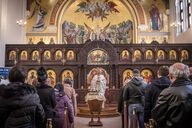
Orthodox Christian Lent
Olivier Donnars / Le Pictorium
LePictorium_0272393.jpg
February 18, 2018: pre-Lenten mass celebrated in the Serbian Orthodox Church of Saint Sava. Paris (75), France.
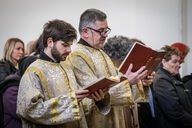
Orthodox Christian Lent
Olivier Donnars / Le Pictorium
LePictorium_0272394.jpg
February 18, 2018: pre-Lenten mass celebrated in the Serbian Orthodox Church of Saint Sava. Paris (75), France.
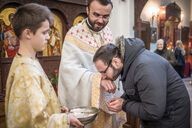
Orthodox Christian Lent
Olivier Donnars / Le Pictorium
LePictorium_0272395.jpg
Feb. 18, 2018: A worshipper kisses the priest's hand during the Divine Liturgy during the pre-Lenten mass celebrated at St. Sava Serbian Orthodox Church. Paris (75), France.
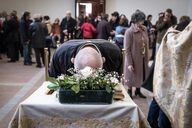
Orthodox Christian Lent
Olivier Donnars / Le Pictorium
LePictorium_0272396.jpg
Feb. 18, 2018: A worshipper kisses an icon placed on the altar in the Serbian Orthodox Church of St. Sava in Paris (75), France.
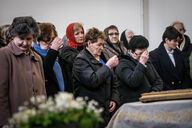
Orthodox Christian Lent
Olivier Donnars / Le Pictorium
LePictorium_0272397.jpg
February 18, 2018: pre-Lenten mass celebrated at St. Sava Serbian Orthodox Church. Parishioners signing themselves during the Our Father prayer. Paris (75), France.
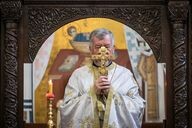
Orthodox Christian Lent
Olivier Donnars / Le Pictorium
LePictorium_0272398.jpg
February 18, 2018: pre-Lenten mass celebrated in the Serbian Orthodox Church of Saint Sava. Paris (75), France.
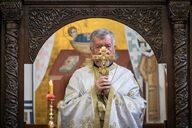
Orthodox Christian Lent
Olivier Donnars / Le Pictorium
LePictorium_0272399.jpg
February 18, 2018: pre-Lenten mass celebrated in the Serbian Orthodox Church of Saint Sava. Paris (75), France.
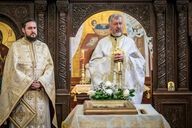
Orthodox Christian Lent
Olivier Donnars / Le Pictorium
LePictorium_0272400.jpg
February 18, 2018: pre-Lenten mass celebrated in the Serbian Orthodox Church of Saint Sava. Paris (75), France.
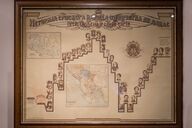
Orthodox Christian Lent
Olivier Donnars / Le Pictorium
LePictorium_0272401.jpg
February 18, 2018: Saint Sava Parish is the episcopal seat of the Serbian Orthodox Diocese of France and Western Europe of the Serbian Orthodox Church. A genealogical chart of the dynasty of Serbian and Yugoslav rulers hangs on one of the walls. Paris (75), France.
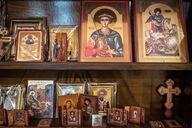
Orthodox Christian Lent
Olivier Donnars / Le Pictorium
LePictorium_0272402.jpg
February 18, 2018: Icons for sale at the entrance to the Church of Saint Sava in Paris, the episcopal seat of the Serbian Orthodox Diocese of France and Western Europe of the Serbian Orthodox Church. Paris (75), France.
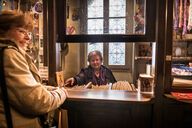
Orthodox Christian Lent
Olivier Donnars / Le Pictorium
LePictorium_0272403.jpg
February 18, 2018: At the entrance of St. Sava's Church, Orthodox parishioners rush to buy candles. Paris (75), France.
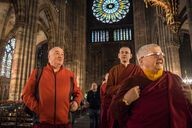
Buddhist pilgrimage with the Dalai Lama
Olivier Donnars / Le Pictorium
LePictorium_0268233.jpg
September 16, 2016: Several monks and nuns from Nalanda Monastery, take advantage of their stay to visit Strasbourg and its Notre Dame Cathedral. Strasbourg (67), France.
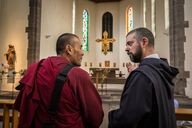
Buddhist pilgrimage with the Dalai Lama
Olivier Donnars / Le Pictorium
LePictorium_0268237.jpg
September 16, 2016: In response to the Dalai Lama's wishes to establish an inter-religious dialogue, the monk Sangpo (l) of the Nalanda Monastery in Labastide-Saint-Georges was welcomed during his pilgrimage by monks of the Jerusalem Monastic Fraternity in Strasbourg. Chapel of the Monastic Fraternity of Jerusalem, Strasbourg (67), France.
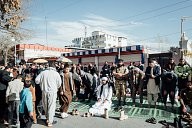
Kabul
Adrien Vautier / Le Pictorium
LePictorium_0256284.jpg
Street prayer in Kabul on November 26, 2021.

Chartres pilgrimage
Julien Mattia / Le Pictorium
LePictorium_0181098.jpg
The pilgrims leave the Parisian capital in the direction of Chartres.
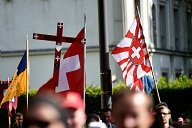
Chartres pilgrimage
Julien Mattia / Le Pictorium
LePictorium_0181099.jpg
The pilgrims leave the Parisian capital in the direction of Chartres.

Chartres pilgrimage
Julien Mattia / Le Pictorium
LePictorium_0181100.jpg
The pilgrims leave the Parisian capital in the direction of Chartres.
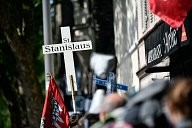
Chartres pilgrimage
Julien Mattia / Le Pictorium
LePictorium_0181101.jpg
The pilgrims leave the Parisian capital in the direction of Chartres.
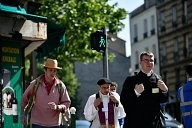
Chartres pilgrimage
Julien Mattia / Le Pictorium
LePictorium_0181102.jpg
The pilgrims leave the Parisian capital in the direction of Chartres.

Chartres pilgrimage
Julien Mattia / Le Pictorium
LePictorium_0181103.jpg
The pilgrims leave the Parisian capital in the direction of Chartres.
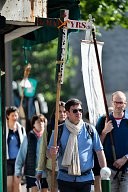
Chartres pilgrimage
Julien Mattia / Le Pictorium
LePictorium_0181104.jpg
The pilgrims leave the Parisian capital in the direction of Chartres.

Chartres pilgrimage
Julien Mattia / Le Pictorium
LePictorium_0181105.jpg
The pilgrims leave the Parisian capital in the direction of Chartres.

Chartres pilgrimage
Julien Mattia / Le Pictorium
LePictorium_0181106.jpg
The pilgrims leave the Parisian capital in the direction of Chartres.

Chartres pilgrimage
Julien Mattia / Le Pictorium
LePictorium_0181107.jpg
The pilgrims leave the Parisian capital in the direction of Chartres.

Chartres pilgrimage
Julien Mattia / Le Pictorium
LePictorium_0181108.jpg
The pilgrims leave the Parisian capital in the direction of Chartres.

Chartres pilgrimage
Julien Mattia / Le Pictorium
LePictorium_0181109.jpg
The pilgrims leave the Parisian capital in the direction of Chartres.

Chartres pilgrimage
Julien Mattia / Le Pictorium
LePictorium_0181110.jpg
The pilgrims leave the Parisian capital in the direction of Chartres.
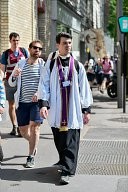
Chartres pilgrimage
Julien Mattia / Le Pictorium
LePictorium_0181111.jpg
The pilgrims leave the Parisian capital in the direction of Chartres.

Chartres pilgrimage
Julien Mattia / Le Pictorium
LePictorium_0181112.jpg
The pilgrims leave the Parisian capital in the direction of Chartres.

Chartres pilgrimage
Julien Mattia / Le Pictorium
LePictorium_0181113.jpg
The pilgrims leave the Parisian capital in the direction of Chartres.

Chartres pilgrimage
Julien Mattia / Le Pictorium
LePictorium_0181114.jpg
The pilgrims leave the Parisian capital in the direction of Chartres.
Next page
